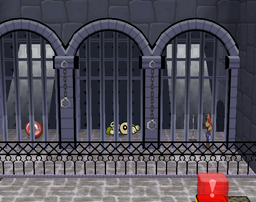Paper Mode: Difference between revisions
From the Super Mario Wiki, the Mario encyclopedia
Jump to navigationJump to search
m (Text replacement - "[Ff]orm-infobox" to "form infobox") |
m (Text replacement - "{{Mario's Transformations}}" to "{{Mario forms}}") |
||
| Line 13: | Line 13: | ||
In ''[[Super Paper Mario]]'', the [[Pixl]] [[Slim (Pixl)|Slim]] has a similar ability. | In ''[[Super Paper Mario]]'', the [[Pixl]] [[Slim (Pixl)|Slim]] has a similar ability. | ||
{{Mario | {{Mario forms}} | ||
{{PMTTYD}} | {{PMTTYD}} | ||
[[Category:Mario forms]] | [[Category:Mario forms]] | ||
[[Category:Paper Mario: The Thousand-Year Door moves]] | [[Category:Paper Mario: The Thousand-Year Door moves]] | ||
[[de:Papiermodus]] | [[de:Papiermodus]] | ||
Revision as of 19:42, May 1, 2022
| Paper Mode | |
|---|---|
 Mario slipping past the bars in Hooktail Castle. | |
| Power(s) given | Slip through narrow spaces |
| First appearance | Paper Mario: The Thousand-Year Door (2004) |
Paper Mode is one of Mario's transformations seen in Paper Mario: The Thousand-Year Door, and the second one obtained. Similarly to his other origami-themed forms, it is granted to him in the form of a "curse" from one of the Black Chest Demons in Hooktail Castle.
Paper Mode allows Mario (and his party) to turn sideways, using his paper-thin body to fit through small gaps. It can be activated by holding ![]() , with Mario returning to normal once
, with Mario returning to normal once ![]() is released. While in Paper Mode, Mario moves more slowly, and cannot use his hammer, Spin Jump, Spring Jump, or use partner abilities.
is released. While in Paper Mode, Mario moves more slowly, and cannot use his hammer, Spin Jump, Spring Jump, or use partner abilities.
The Paper Game, a minigame in the Pianta Parlor, utilizes this move.
In Super Paper Mario, the Pixl Slim has a similar ability.